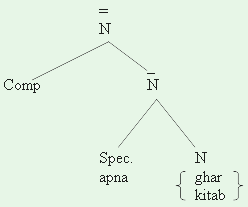| (22)
|
|
ram
apne ghar ja raha hai
i i
Ram
self home go+PRES
(Ram
is goes home.)
|
| |
|
|
| (23) |
|
ram
ne mohan ko apna ghar dikhaya
i i
Ram CM mohan CM self home show+PAST
(Ram showed Mohan his house.)
|
| |
|
|
| (24) |
|
ram
ko apna ghar accha lagta hai
i i
Ram
CM self home nice perceive+PRES
(Ram
likes his own home)
|
| |
|
|
| (25) |
|
ram
ne mohan se [PRO apni kitab parne
i j
i,j
i,j
Ram
CM mohan CM PRO self book read+Nom
ke
liye] kaha
CM
say+PAST
(Ram
asked Mohan to read his book)
|
|
| |
| (23) has a causative verb and (24) is a dative-subject
construction. The structure of the apna-phrase in these
can be diagrammatically represented as follows: |
| |
| (26) |
|
 |
| |
|
|
|
| In each of the sentences above apna
refers to ram. In (25), it refers to mohan
also, thereby making the sentence ambiguous. We will discuss
(25) shortly. In (22) and (23), ram bears the agent
theta-role. In (24), ram bears the perceiver theta-role. |
| |
| In (25), apna has ambiguous reference,
referring to the non-agent, non-perceiver mohan
in one of its interpretations. Thus, on the face of it,
the sentence seems to be a counter-example to (15). But
it is not. Notice that in the embedded constitutent the
antecedent of apna is PRO which bears the agentive
theta-role. When we discuss the PRO-antecedent relationship
in the chapter on PRO, we shall show that PRO, being a
pronominal anaphor, chooses both the agent and the non-agent,
non-perceiver as its anteceent in sentences such as (25).
Thus in (25), apna refers to both ram and mohan
only indirectly, that is, through PRO. Therefore, (25)
is not a counter-example to (15). |
|
|
|